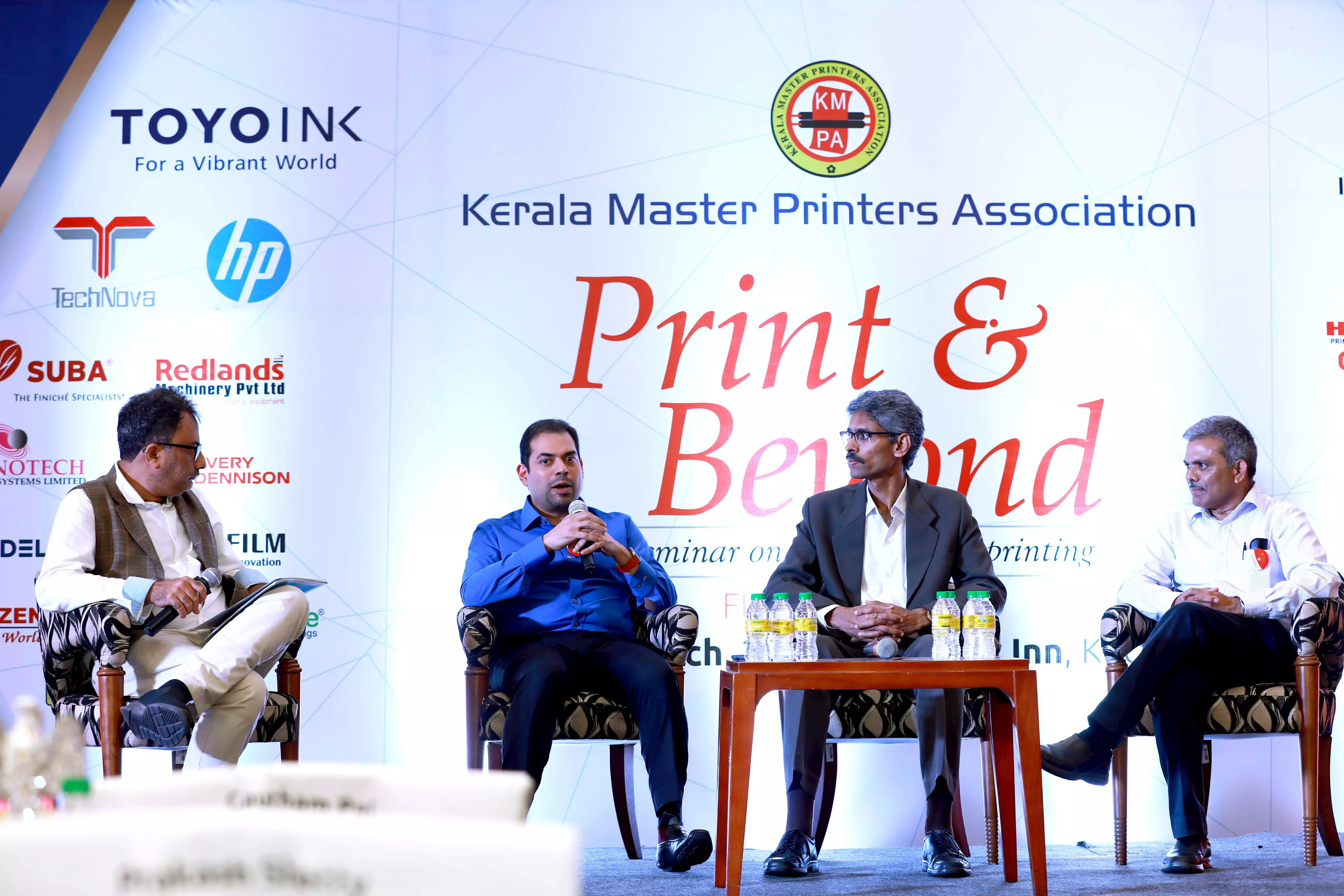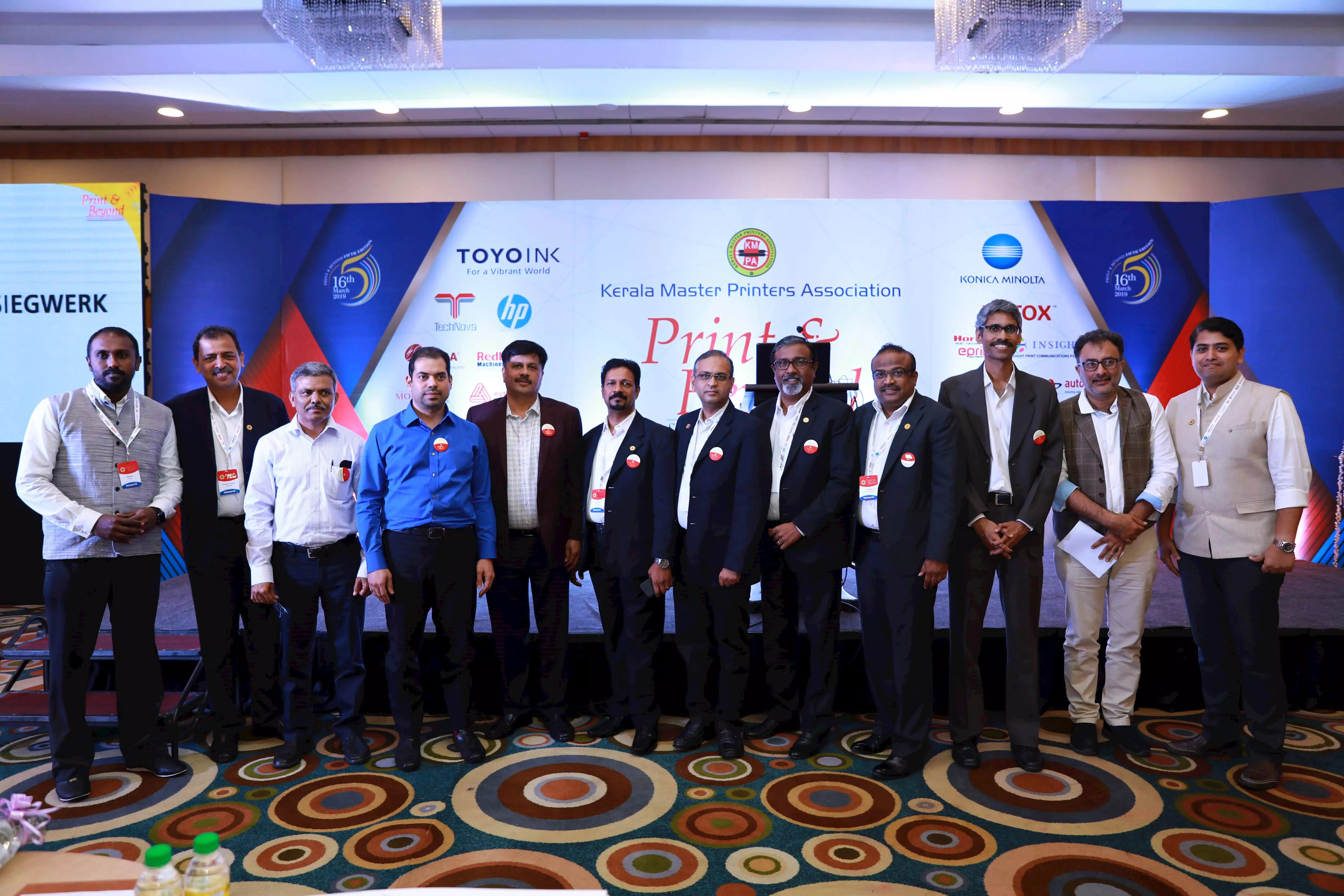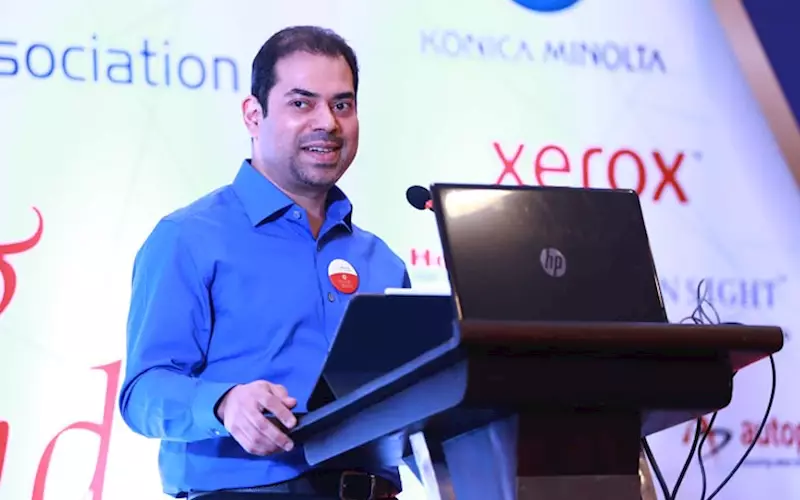Gautham Pai: How I see things going forward ...
The Kerala Master Printers Association hosted its conference Print and Beyond themed around Make in India: Success Stories in Print.
Gautham Pai, chairman and managing director, Manipal Technologies, delivered the keynote. He said, "After speaking to the KMPA printers, I felt the most pressing thing on people's mind in the print industry is the future of print, the challenges, and questions about the path one can take to grow the business..."
This Sunday Column is about the Numero Uno in the Power 100: Gautham Pai
09 Jun 2019 | By Noel D'Cunha
Excerpts from the speech
In India, it’s been a little challenging due to multiple factors. First, there was a demonetisation. Then, many issues crept up with the introduction of GST. And then, for the Kerala printers, the flood was a huge setback. But, I think barring this if you look at it from a macro perspective, India has been an exciting place for businesses compared to most places.
First, there is the population dividend – more than 50% of our population is below the age of 25. So I think it’s a new India, even though Indians have always been entrepreneurial. Regrettably, colonisation and the entire license raj destroyed entrepreneurship in India. It decimated our confidence.
During dinner, a print owner shared his story. When his father handed over the business to him, the dad said, “I’ll hand over the business to you, but you cannot take any loans.” When the son stepped out, he got a loan issued without informing his father that he was borrowing money from friends. That was the start of his journey.
That’s why I think entrepreneurship is one of the biggest and most exciting factors in India. And we are really going back to our glory days of the 1700s when India boasted 25% of the world’s GDP. Likewise, China. Today we are accelerating. In the next decade, we will be among the top three or third largest economies of the world. This is due to the entrepreneurial genes in our blood. I see a return with a new sense of confidence.
Whether it’s the entrepreneurs in India starting new businesses or people across the world who have been building global businesses, in the previous generation being an entrepreneur was the last choice. Everyone aspired to be a professional – a doctor or engineer. Today, being an entrepreneur is the first choice. And parents are supportive of it. Failure is accepted. It is not seen as a taboo.
The print economic
The per capita income in India has been growing over the last ten years. In 2009, it was USD 1,100. Last year, it was about USD 1900 - and is expected to be USD 2,700 in the next three years. Good news? Yes. But this is versus China’s per capita income of USD 8,000. So, India is ten years behind China. The significance of this is that when the per capita income goes beyond a tipping point, we have extra money to spend. Till then, the basic needs are taken care of. So, when that surplus money is spent, we start visiting restaurants and going to movies. Then, we purchase things and drive consumption in India.
The per capita consumption of paper in India is low. It’s about 11kg versus China’s 75kg annual consumption. From mobile phones to magazines, the consumption spend is on the rise. Now if the purchase is an online product, then that product has to be packaged. Nowadays, most homes have one or two boxes being delivered from Amazon or Flipkart. A lot of that product is packaged much differently than in the traditional store. It doesn’t require a lot of carton structure but a robust corrugated box. So we have to be aware of the consumer trends and understand where the customer is spending money, what their expectations are, and how we need to tweak our process. Sounds easy; but as they say, being prophetic about the future is easy, getting it right is tough.
How do we make the right prediction? When Henry Ford wanted to set up the automobile business and make cars, his banker advised the president of Michigan’s banks in 1903 that automobiles are a fad and horse carriages are here to stay.
Now, look at what is happening. Uber and Ola are disrupting the automobile business. But if you look at the underlying cause and effect, the need for transportation remains. The business model may change. But the need for transportation survives.

Print and Beyond: Pai (second left), with panelists Ramu Ramanathan, Prakash Shetty of Bizongo, and B Prasad of Printech Digital Imaging
Print diversity
So how do we look at our businesses? The point is, the print industry is not a single entity. It produces an array of specialised forms of products - commercial print products, labels, OOH etc.
It’s like a foreigner who arrives in India and says he wants to eat Indian food. But Indian cuisine is diverse; each state has its own gastronomical specialisation. In fact, within a state like Karnataka, there are four distinct types of food. There is the Shetty, Bunt, Konkani and Brahmin style of food preparation.
The print is as diverse. I think we need to examine each industry individually and study its dynamics of growth, technology, process, end customer, etc. Today, why are a lot of commercial printing companies diversifying into packaging? There is a notion that packaging will never disappear. Thus, to safeguard one’s business, they foray into the packaging. Thus, an offset sheetfed printer adds a folder-gluer and die cutting plus some fancy finishing kit, and they can build a packaging plant. Many companies are doing it. Ultimately it becomes so competitive that it doesn’t change the situation.
Investing in packaging is not bad, but we need to explore where there is hunger. And therefore, to use the restaurant metaphor, we need hungry people. Whether you serve a basic quality of food or you are a gourmet restaurant, not having hungry people does not help.
Whichever industry you are in, finding hungry people is of utmost importance.
Evolve to meet print needs
When the telecom boom transpired in 2006-2007, we were primarily into commercial print. Also, we had security print, which meant printing cheque books, share certificates, business forms such as couriers and labels. So when the telecom boom occurred, our research suggested India is going to be a prepaid market and we need to look at recharge telephone cards.
Most people didn’t agree with us. After all, what does a printing company know about manufacturing cards, it’s a different process. It’s a lot about die cutting, variable data, etc. But it turned out to be a great business. And in a short time, that business prospered from zero to Rs 80 crore.
During that time we had customers from Mumbai sitting at our plant, as they needed to run their business and they couldn’t do it without having recharge cards. Thus, instead of my team chasing customers, the telecom bigwigs were seated in Manipal and offering to pay extra to produce our cards first.
However, there’s a downside to this.
The entire business shifted into digital space. Today that card businesses is zero. Rs 80 crore to zero. It is the same as other businesses. For example, we produced food coupons where the Government distributes coupons and the citizens, instead of visiting the ration shop, could accrue direct benefits from the food coupons. Again, it used to be a Rs 50-crore business. Today it is zero. Likewise one of our biggest businesses of printing telephone directories is zero.
So there are segments which are growing, but there are segments which have disappeared and more will continue to disappear. Always keep that in mind.
How do you grow?
The big question is, how do you look at the industry going forward?
Our team thought about the end application. Say it is a food coupon, then what is it being used for? And is there something which we can do to disrupt the noise? Or has someone altered the market? Then we ask ourselves, can we create a leadership position? Let me illustrate. When I joined the company, it was called Manipal Power Press. Then it was called Manipal Press. Because at one point of time, Manipal Power Press was actually one of the top three in the country in commercial painting. This was in the mid-90s. Then it lost focus. No investment, so that business did not grow.
We got our first four colour machine in the early 2000s. When I joined the business, like every young adult, I wanted to grow it. But how do we do it? What are the various segments in print? How do we provide better solutions to the customers?
To answer these questions, we started developing more knowledge- and application-based solutions. Hence, our goal for the next five-seven years was to gain 30%-40% in revenue from our solutions and products.
This transformation started by renaming the company, Manipal Technologies, and it has been an interesting journey ever since.
An example of our transition was how we printed bank cheques. Back then, this banking instrument was used extensively, but because of India’s growth and development, the usage of cheques decreased. We needed to evolve. Therefore we tapped into a tiny market at that time: credit and debit cards. We understood the printing part of this project, but we had limited knowledge in plastic and the entire process of creating these cards. So to reduce our learning curve we partnered with a company who had more experience in the processing of the cards.
After working on this for 22 months, we had a 60% market share in the banking industry!
Change is constant
As technology develops, India evolves. Today, the country is migrating to mobile-based transactions, such as UPI (United Payment Interface) and Aadhar.
We had to change with the times. We set up a business in virtual cards. These are credit cards, but with security. Plus they can be accessed through your mobile phones.
This worked very well in urban India. However, in rural India, we needed to find another solution. So we set up an acquiring business where we enable merchants to make minimal digital payments.
We started acting on this plan eight months ago. And now we have about 75,000 merchants in rural India. We have built on this ecosystem, and have enabled the same merchants to do mobile recharging as well. While developing a solution, always look at the end application.
Another example was creating a solution to avoid situations such as standing in long queues and waiting for days just to open a new bank account. The answer to this was building a kiosk.
The State Bank of India started a new venture called In Touch branches. The customer can insert his fingerprint through his Aadhar card, and a new bank account will be created within minutes. The customer walks off with a personalised debit card and a cheque book, within five minutes. By providing the cards, cheque books and maintaining the machines, we were protecting our print business.
Another way to develop solutions is by answering the question: What capabilities do we have as an organisation – what additional capabilities /competence, we need to acquire to meet market demand?
As an individual company, we could print the credit cards. But we did not know how to proceed with the manufacturing process. So we found a partner to create a joint venture. Now we have a team that produces printed electronic products, like EL displays, printed heaters and other products. But, we don’t have a market connect to that industry, as of yet. Currently, we are trying to build it (competence has to be acquired or built).
We deployed our printing, screen printing, and laminating machines. Also, we hired people with materials science experience. This gave a lot of exposure to the current team in terms of printed electronics. We tied up with educational institutions such as IIT Kanpur. We hired two people who invested a lot of money in their own lab. Because we cut down on costs over there, we started a small lab at MIT (Manipal Institute of Technologies). This is an example of how we can tap into what we have and build a better and more connected market.
ITC has created an excellent distribution system with its cigarette business. They took advantage of their Peshawari cooks in their hotels and developed that into packaged food. This sells like hotcakes. They combined their strengths, acquired some land and built a packaging food business. This is a good example of how a business can grow.

Team KMPA with speakers during the annual Print and Beyond seminar in Kochi
Customer relationship is an asset
There are three parts of the business that can take place in today’s day. The first part, as I mentioned earlier, look at what the end application is. Ask yourself – is there space in that sector? How can I change that industry? Is the area that I want to work in right for me?
We underestimate the assets we have. The relationship with a client is an asset; understanding the local geography is also an asset. Today, it’s not merely the physical asset that is important. We need to pay attention to intangible assets which are sometimes ignored and taken for granted.
During the KMPA get-together, someone asked me about the number of printing equipment and kit we own. My answer to the question as I do not get involved in buying machines because they perform the same way. The only factor that I focus on is the people we hire because that is more valuable. This drives the business.
Finding a specialisation is important. To focus on one area is crucial because of the competitive nature of our industry. We have two options, create a niche or scale up and become more dominant. In between these two options is where the big problem lies. When we get into mid-sized businesses, we have a different cost structure (higher fixed cost ), We are neither here nor there. But if you’re niche we are small; we can still be extremely profitable. Or we have to really scale to a large size.
Always have clarity about your situation. At the end of the day, providing a five-star experience to the client is what matters the most. Once you stay in a five-star hotel multiple times, staying in a lodge becomes uncomfortable. That is the kind of experience that you need to provide to your client. It should be impossible for the client to go to another company. You need to make sure that they return to you. And if they shift to another company, it should feel like a downgrade for the client.
Amazon is a perfect example of excellent customer service. They have built their business entirely on customer experience; everything else is secondary.
As our economy is growing, the industry becomes competitive. All of us are competing at three levels, knowing or unknowingly. The first level is competing for ideas. The second level is competing at an operational level i.e. execution of the idea, and the third level is competing for resources. It can be resources from the bank or an investor. In order to build a scalable business, we have to win at all three levels.
Being open-minded and learning from others is most important. We should be open to ideas and should consider other people’s opinions. Arguing with one another is okay as long as we do it with the intent of learning rather than proving the other person, wrong.
Message to the print industry
Finally, my message is that print is in a truly exciting field. But, we have to rethink the terrain that we play in. And above all, work on giving the customer what is required.
Learning from one another and being open-minded is what we need. We have a fantastic opportunity to build this industry and take it to greater heights.
Thank you.














 See All
See All